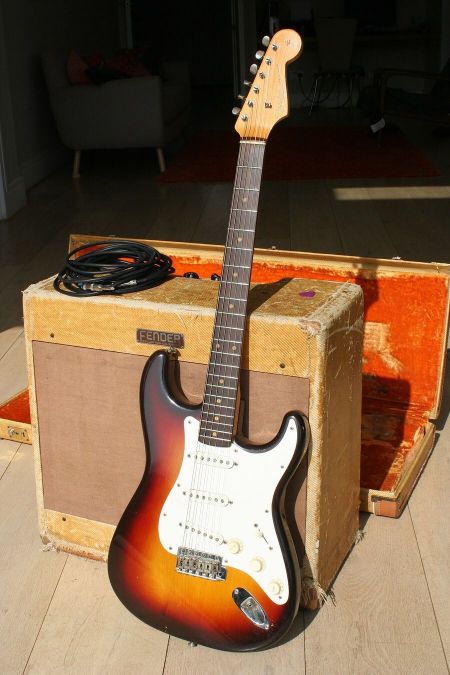Stratocaster: Difference between revisions
Amwelladmin (talk | contribs) No edit summary |
Amwelladmin (talk | contribs) No edit summary Tags: Mobile edit Mobile web edit |
||
| Line 1: | Line 1: | ||
{{a| | {{a|devil|[[File:59 strat-1 1.jpg|thumb|centre|450px|a 1959, rosewood slab-board [[Stratocaster]]. ’59 was a good year.]][[File:Strat.jpg|450px|thumb|center|Says it all really.]]}}The greatest piece of design in the last two hundred years is Leo Fender's wonderful [[Stratocaster]]: a design so good that noone has managed to improve it at all since Fender invented it in 1954. Ok: maybe the introduction of a rosewood fretboard in 1959. But that’s it. And it kills fascists, too. | ||
[[ | ===As a [[design]] classic=== | ||
So what is under the hood? The components of the Stratocaster are designed for simple production line manufacture and then easy maintenance. the guitar is modular in that almost all of the replacements can be easily replaced or upgraded. | |||
But the stuff the player needs to be able to adjust “on the fly” — the tuning machines, pickup selector and volume and tone controls — are intuitive, well-placed, and don't get in the way. | |||
More specialised adjustments (action, intonation, and and neck bow — things a player would not normally need to adjust once the guitar is correctly set up) can be be made quickly with the aid of simple tools and without disassembling the guitar. These these adjustments you might expect a specialist guitar technician to to do. More fundamental adjustments, by way of repair or or or replacement of parts are also possible, by disassembling the guitar and with elementary electrical work (soldering). Only parts which are are vital to the engineering of the instrument —the frets, which must be spaced exactly in relation to each other and never been to be adjusted — cannot be replaced except by a Luther. | |||
{{sa}} | {{sa}} | ||
*[[Telecaster]] | *[[Telecaster]] | ||
*[[Electric guitar]] | *[[Electric guitar]] | ||
Revision as of 18:17, 5 December 2020
 
|
The greatest piece of design in the last two hundred years is Leo Fender's wonderful Stratocaster: a design so good that noone has managed to improve it at all since Fender invented it in 1954. Ok: maybe the introduction of a rosewood fretboard in 1959. But that’s it. And it kills fascists, too.
As a design classic
So what is under the hood? The components of the Stratocaster are designed for simple production line manufacture and then easy maintenance. the guitar is modular in that almost all of the replacements can be easily replaced or upgraded.
But the stuff the player needs to be able to adjust “on the fly” — the tuning machines, pickup selector and volume and tone controls — are intuitive, well-placed, and don't get in the way.
More specialised adjustments (action, intonation, and and neck bow — things a player would not normally need to adjust once the guitar is correctly set up) can be be made quickly with the aid of simple tools and without disassembling the guitar. These these adjustments you might expect a specialist guitar technician to to do. More fundamental adjustments, by way of repair or or or replacement of parts are also possible, by disassembling the guitar and with elementary electrical work (soldering). Only parts which are are vital to the engineering of the instrument —the frets, which must be spaced exactly in relation to each other and never been to be adjusted — cannot be replaced except by a Luther.